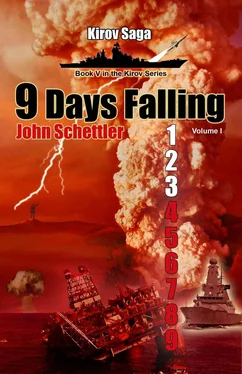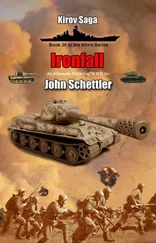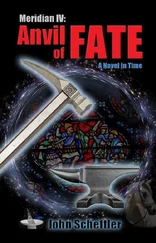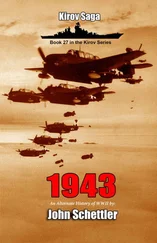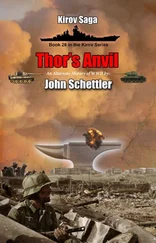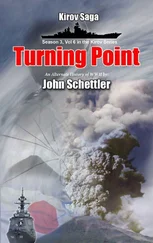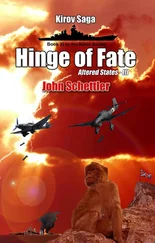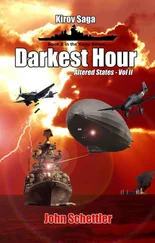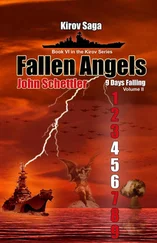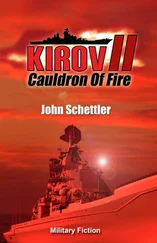The planes had a big KH-32 under each wing and a reserve on the fuselage. When they received the signal, they fired their wing mounted ordnance, sending thirty of the deadly new supersonic cruise missiles streaking away and climbing for the stars above. They would more than double their launch altitude before they tipped their noses over at apogee and began to seek the distant American battlegroup. Thirty supersonic kamikaze missiles would soon be heading south to find the American carrier. By the time they descended for their final plunging attack run they would be coming at over Mach-5, their noses glowing red with the heat of the friction in the atmosphere… and they would not be alone.
A bastion of attack submarines were off to the south, now entering cruise missile range of the American task force. Three Akula Class attack submarines were spread out in the vanguard, forming a screen against intruding enemy subs. Their job was simply to find and attack any enemy submarine attempting to penetrate the screen and threaten the next group of SSGNs. Two older Oscar Class subs were following them, the Omsk and Viluchinsk . They carried some vintage cruise missiles, each with twenty-four of the old P-700 Granit “Shipwreck” missiles. With a range just over 600 kilometers and a heavy 750 kg warhead they posed a grave threat.
Behind them came the pride of the Russian undersea fleet, the new Yasen class boat, SSGN Kazan . Here were no less than forty P-900 “Sizzler” cruise missiles, fast sea skimmers with a high speed terminal run programmed for dizzying evasive maneuvers.
Karpov counted down the seconds, knowing his Backfires had their missiles in the air by now, and holding his breath as the time ticked off. He wanted to give his missile fire order to the sub bastion to coordinate the time on target as closely as possible for each weapon system involved. He had worked out his initial attack the previous evening, laboring late into the night to check and double check each detail of the plan. He had even coded everything into discrete message transmissions to be sent at crucial intervals as the action unfolded. The time was now.
“Nikolin! Send low frequency transmission undersea Order One as programmed.”
“Sir, aye, sending undersea transmission one.”
If all went according to plan there would soon be a salvo of twenty of the slower P-900s from Yasen , half of the boat’s missile arsenal. Undersea Order Two would send twenty-four of the faster P-700 cruise missiles from the two Oscar class boats leaping from the sea like a school of angry flying fish and skimming right over the wave tops toward the American carriers. These forty-four low altitude missiles would be added to the thirty KH-32s off the Backfires , soon to be falling like meteors from the edge of space.
Karpov looked at his watch, then glanced up at the ship’s chronometer, mentally calculating something in his battle mind. The American strike planes were almost at the AEW line and closing, about 400 kilometers out. Rodenko reported multiple contacts inbound, with data fed by Black Bear, but that plane had but seconds to live. He had to act at once.
“Rodenko! Feed AEW data to Samsonov at once to fix the position of the American strike groups. When we lose Black Bear switch to predictive plot. We know where they are headed and our systems can calculate their course and speed easily enough. Sound air defense alert and signal all fleet units! Samsonov, I want the S-400s ready, four salvos of eight. Concentrate your fire on the Alpha strike group coming in from the Hokkaido coast. Kuznetsov’s fighters will handle the Beta strike group.”
Rodenko was quick to comply and Samsonov soon had good live targeting data on the planes coming in off the coast of Japan. They would lose the contact soon enough until the ship re-acquired them with her own radars, but the computers would continue to project a predictive plot based on the last live course heading and speed they had obtained. The S-400s would be keyed to intercept based on that plot until their active radar could redefine the precise location and home in. The Captain was going to deliver yet another surprise, for the Americans would not expect SAM defense for some minutes, until they were inside the 300 kilometer range of his older S-300s. But the new S-400s had an extended range to 400 kilometers, and they could fire at once.
Captain Tanner wanted to try his patience that morning, and he would now pay the price. Rodenko turned to Samsonov and nodded. Karpov gave the order to fire and the missile warning sounded as the first of the S-400s were up and away. Like an old veteran returning to the front, wounded, bandaged and yet resolute, Kirov was at war.
~ ~ ~
Farto the South Captain Tanner got the bad news soon enough. He was sitting in the Captain’s chair on the bridge of CVN Washington , and about to have a very bad day. His AWACS coverage soon reported the Backfire strike group, but they had fired from well beyond 600 kilometers.
“Deaken!” He wanted his weapons specialist. “What’s coming at us off those damn Backfires? They’re over 800 klicks out!”
“Can’t be throwing the kitchen sink at us at that range,” said Deaken. He was referring to the KH-22 “Kitchen” missile with a maximum range of 600 kilometers. “Has to be something new—probably the KH-32.”
“Well, what about it?””
“World of pain, sir. High angle attack. Sucker climbs to the upper edge of the atmosphere, acquires, and then dives on the target.”
“Just what I didn’t need to hear.”
“Sir!” Deaken had just picked up another missile launch warning from the AWACS. “We’ve got multiple missiles inbound, 300 klicks out. Those have to be off subs!”
“Well where the hell is our screen?”
Skip Patterson was at the Captain’s side and the XO had a serious look on his face. “That bastard stole a march on us, sir.”
Tanner leaned back, shaking his head. “All’s fair in love and war, Skip. This guy Karpov thought things out real good. He knew we were reneging on that deal an hour ago and he had a sub missile group right on the AEW line ready to bushwhack us. Where are our boats, damnit?”
“They probably had them on sonar sir, but the kill orders just went out. The Russkies just beat us to the punch, but they’ll be after those subs now. Bet on it.”
“A lot of good it does us now, Mister Patterson. They got their shot off, and that’s all that matters. The Backfires were another surprise. Every drill we’ve ever run had them launching inside 600 klicks. Alright people,” Tanner raised his voice. “It’s about to get ugly. Better hope Shiloh and the boys on those DDGs are on their game today. We’ve drilled this for years, but this is the real McCoy. Signal all units—weapons free. Prosecute, prosecute, prosecute.”
“Aye sir, all units track and prosecute vampires. AWACs has the sub surface launches still in booster phase. We should get them on the SPY system at tip-over when they hit our radar horizon.” The US AEGIS defense system was about to get its first real war test, and the SPY-1D/3D radar would be the first shipborne system to pick the missiles up as they tipped over after the initial boost and then descended to their low level sea skimming altitudes for the target approach.
“How fast are these new ALCMs, Deke?” Tanner was trying to calculate his kill chain probabilities here.
“The KH-32s? Very fast, sir. They’ll be humming at Mach 5 when they hit our radar horizon and at least Mach 3.5 if they make a low level run after that. We’ll have one good shot, maybe two at that speed. Double that for the Sizzlers because they run subsonic until the final approach. And we can beat on the older Shipwrecks all day. They’re fast, but with a radar cross section that big we’ll lock and track them easily enough. We’ll only get a couple shots at them, but one should do.”
Читать дальше
